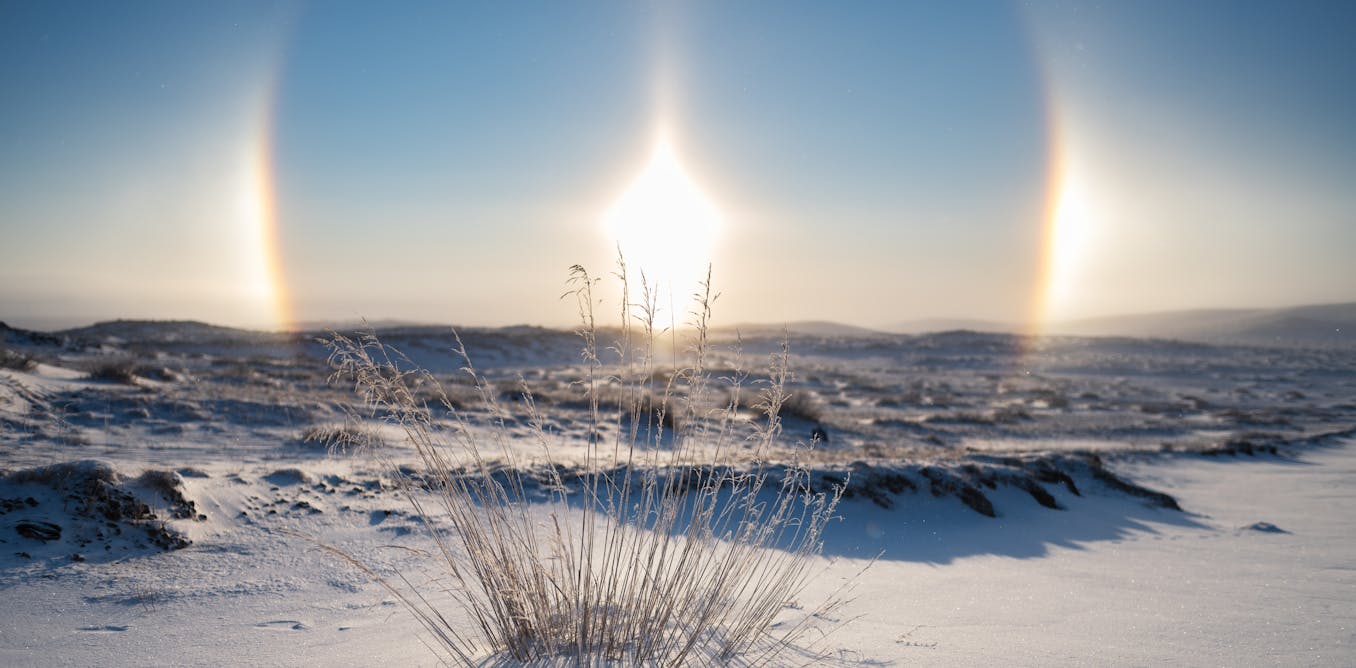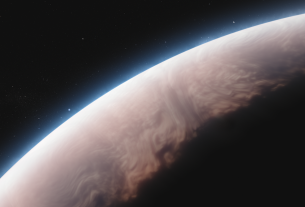
Every once in a while, you may look up towards the Sun and see strange bright lights on either side of it. Or perhaps you’ll be sitting in an aircraft, looking out the window at its shadow and see a circle of light, like a halo below (known as glories). Or, if you’re really adventurous, maybe you’ll even be out on a midnight walk with a full moon lighting your way, and see what appears to be a rainbow encircling the moon.
These are all beautiful examples of atmospheric optical phenomena. And a new paper has suggested they may appear in alien skies too.
These celestial wonders can tell us a lot about the state of the atmosphere at home on Earth as well as on other planets. Rainbows, for instance, the most well-known of these phenomena, can only form when light passes through spherical liquid droplets, like our normal rain on Earth. Therefore, there must be spherical liquid droplets in the atmosphere where the rainbows are observed.
Most planet atmospheres have some kind of crystalline aerosols (clouds of tiny particles) in them, from sodium chloride in Io (one of Jupiter’s moons), to carbon dioxide crystals in Mars. On Earth, these are generally ice crystals, often found in clouds as snowflakes. The orientation of these crystals, and how they change the light, dictates the type of optical phenomena you can see.

Ray Majoran/Wikimedia, CC BY-SA
Sun dogs are another of these phenomena, where bright lights appear on either side of the Sun, sometimes even splitting white light into the colours of the rainbow. They form because of the light being bent by horizontally oriented hexagonal ice crystals high up in the atmosphere. If you want the best chance of seeing these, you should try to be at the same latitudes as Europe or Argentina during wintertime. Look for high altitude wispy clouds that are in front of the Sun, and you might get lucky.
Horizontal ice crystals can also create light pillars in extremely cold conditions, which look like coloured beams of light trailing to clouds over head. Vertical crystals form parhelic circles – a circle of light at the same height as the Sun. And crystals aligned with the electric fields above thunderstorms create crown flashes.
The new paper proposes that, from what we know of our own atmosphere, we can presume that similar optical phenomena happen on planets outside of our solar system (called exoplanets). It’s just a matter of spotting them and finding out why they occur.
Previous studies have shown that on many exoplanets the crystalline aerosols in their atmospheres are moved around and oriented in a multitude of different ways, much like on Earth.
Magnetic fields swirl around the planet, as they do on Earth, pushing and pulling along field lines. On Earth, this can be seen as the northern lights phenomena. Radiation pressure from a planet’s parent star pushes the crystals using the power of light, much like how the wind pushes boats. And the wind, often much faster than anywhere on Earth, speeds around the exoplanet, rushing from the hot, star-facing side of the exoplanet to the colder space-facing side as the planet spins.
A special type of exoplanet, hot Jupiters (so named because they’re huge, gassy and very hot) generally have incredibly fast winds (up to 18,000km/h) and high densities of crystalline aerosols, much like an incredibly fast-moving sandstorm.
This means that the main way that the crystals are oriented is through the superfast winds spinning around the planet. Imagine a fleet of boats all randomly turned around in a patch of ocean, then a massive gust of wind comes, turning them all so that they’re facing the same direction.
The researchers on the new paper previously used the James Webb Space Telescope (JWST) to find evidence for tiny quartz crystals in the high altitude clouds of a hot Jupiter 1,300 light years away from Earth (WASP-17 b). These crystals have an elongated shape, like boats, so are more likely to be oriented with the wind. This led them to think about what optical properties could be seen with the wind-aligned crystals.
The optical phenomena that come from the crystals being oriented the same way cannot be seen by normal cameras. But scientists can use instruments such as those on the JWST to observe these effects.
We have already gained valuable information about faraway atmospheres from looking at their optical phenomena using the JWST. For example on Venus, rainbows and glories have been used by scientists to decipher the mysteries of Venus’ extreme heats and yellow colour.
A similar technique of observing glories has been used to detect the presence of long-lasting clouds on the exoplanet WASP-76b. The new knowledge of these clouds gives us insight into the exoplanet’s atmosphere. Now we know that there can be conditions for a stable temperature, which surprised scientists as half of the planet is hot enough to melt iron.

ESA, CC BY-SA
We can also guess what optical effects might occur on planets where we know what the atmosphere is made of. For example, in the high atmospheres of Jupiter and Saturn, where a special type of ammonia crystals are concentrated, we would expect to observe four separate sun dogs. Alas, on Earth, we can only ever see two at a time due to the shape of our atmospheric ice crystals.
Who knows what other wondrous phenomena we may see on other worlds. Who’s to say whether there couldn’t be a planet surrounded by continual rainbows? There is much more to learn about so many exoplanets. Optical phenomena such as sun dogs can tell us huge amounts about their atmospheres, which could help us in the search for habitable planets in the future.
![]()
Peter Berthelemy does not work for, consult, own shares in or receive funding from any company or organisation that would benefit from this article, and has disclosed no relevant affiliations beyond their academic appointment.



